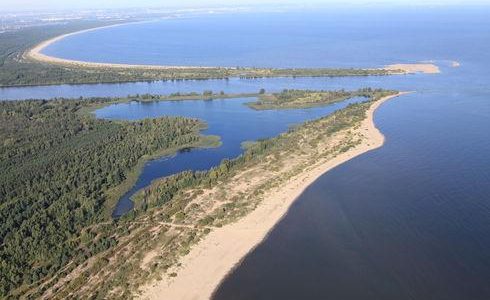Today’s Westerplatte, the land which gradually emerged from the sea over the centuries, was initially part of the whole system of large and small islands which kept appearing and disappearing over hundreds of years. Natural processes typical for the mouth of a river, together with human activities preventing these processes, led to the creation of two large islands on both sides of the river. Flat and sandy fragments of land were referred to in Gdańsk as “plates”. The two islands were simply called the “eastern plate” and the “western plate”, i.e. Ostplaate and Westplaate. Over the years the eastern one connected itself to the land in the area of the Vistulamouth Fortress (Twierdza Wisłoujście) and ceased to be an island. Only the western one, Westplaate, remained separate and was already referred to as “Westerplatte”.
During the 1830’s a bathing resort was organised on the island, which already was covered by a forest. The place quickly became one of the favourite spots for family picnics for Gdańsk residents. The Sopot resort already existed then but there was no efficient transport between Sopot and Gdańsk at the time. Westerplatte, on the other hand was quickly and quite conveniently available via the water route from the city centre.
The Westerplatte resort was referred to as “Sopot in miniature”, having all the necessary attributes of the 19th century health resort. There was a cafe, restaurant, guest houses, and baths for gentlemen and ladies. As well as family baths, there was a pier and water health treatment centre. Soon after the resort infrastructure was constructed at Westerplatte the old mouth of the Vistula was corrected and Westerplatte became a peninsula. The bathing resort ceased to exist by the end of the First World War as Westerplatte was assigned to Poland for creating a trans-shipment base for the weapons and ammunition imported by sea. The establishment of the Army Transit Depot excluded the Westerplatte area from the Gdańsk urban territory.
The 1930’s were the most important times in the history of Westerplatte, with black clouds gathering over Europe and inevitable armed conflict on the horizon, which made Polish authorities prepare the peninsula for defensive purposes. An extremely classified and confidential project was implemented over several years before the start of WWII of the total transformation the warehouse areas into a well-designed field fortress. The qualities of the project and its implementation, as well as the combat abilities of its staff, were fully displayed during over six days of defence in 1939. The morale and effectiveness of the defenders in the light of the hopeless situation grew into a legend and a myth even before they surrendered.
Today’s Westerplatte, divided between the harbour, an army unit and the battle museum area, is slowly changing in its character, typical of the 1960’s, when it was designed, and is becoming an interesting open-air museum. It remains an obligatory visiting place on the route to Gdańsk, and is constantly developing, especially with regard to its outdoor exhibitions, which cover the whole history of the peninsula and not only the most important, but short, war episode it was involved in.



















